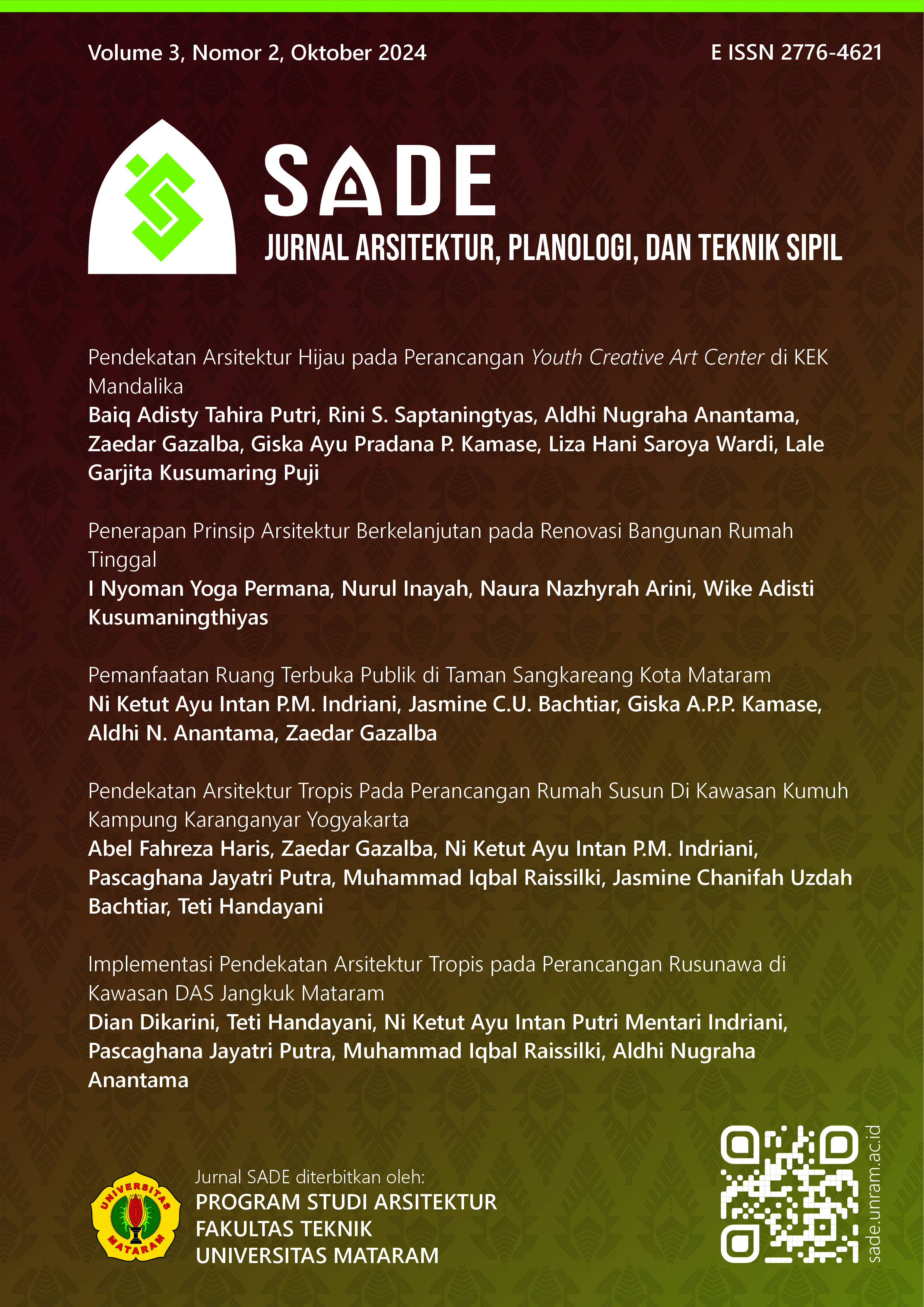Pemanfaatan Ruang Terbuka Publik di Taman Sangkareang Kota Mataram
DOI:
https://doi.org/10.29303/sade.v3i2.86Keywords:
publik space, utilization of space, spatial behaviour, physical settingAbstract
Public open space is an important element in urban design that accommodates the movement space and activities of the city community. The arrangement of public open spaces needs to adapt to the needs of the community and become a friendly space for various activities and social interactions. Sangkareang Park is the center of public space for the people of Mataram City and accommodates a variety of community activities. Activities that occur repeatedly in public spaces form spatial behavior patterns in the use of public spaces. The use of public space that is not in accordance with the physical setting can interfere with the comfort of activities so that there needs to be an evaluation and adjustment between the pattern of space utilization and the physical setting of public space. The purpose of this study is to identify spatial behavior patterns of visitors to Sangkareang Park based on the behavior of space utilization in each physical setting so that it can be used as a reference in the arrangement of public space in the future. This study uses qualitative descriptive methods and behavior mapping techniques. The results of the study show that the pattern of space utilization in Sangkareang Park tends to adjust to the physical setting, can expand to certain conditions that are influenced by the time and activities that take place, and some activities are formed not according to the function and spatial setting. In addition, several attributes were also found that emerged due to human interaction with the environment in public spaces.
References
Anggiani, M., & Rohmat, I. (2020). Persepsi Kenyamanan Pengunjung Ruang Terbuka Publik Perumahan. Vitruvian, 9(2). https://doi.org/10.22441/vitruvian.2020.v9i2.003.
Ardiansari, E., Ernawati, J., & Nugroho, A. M. (2015). Faktor Penentu Setting Fisik Dalam Beraktifitas Di Koridor Jalan Sebagai Ruang Publik (Studi Kasus Kampung Kauman Desa Pakuncen Kabupaten Nganjuk). Review of Urbanism and Architectural Studies, Vol. 13(No. 2), 20–28. https://doi.org/10.21776/ub.ruas.2015.013.02.3.
Carr, S. C., Francis, M., Rivlin, L. G., & Stone, A. M. (1992). Public Space. Press Syndicate of the Univesity of Cambridge.
Effendi, D., Waani, J. O., & Sembel, A. (2017). Pola Perilaku Masyarakat Terhadap Pemanfaatan Ruang Terbuka Publik di Pusat Kota Ternate. Spasial, 4(1), 185–197.
Budiharjo, E. (1998). Kota yang Berkelanjutan. Direktorat Jenderal Pendidikan Tinggi, Departemen Pendidikan dan Kebudayaan.
Kustianingruma, dkk. (2013). Fungsi dan Aktifitas Taman Ganesha Sebagai Ruang Publik di Kota Bandung. Jurnal Reka Karsa, 1(2), 1–14.
Ratnasari, A., & Permatasari, R. (2019). Diskrepansi Pemanfaatan Ruang Publik berdasarkan Teritori Ruang (Studi Kasus: Alun-alun Kota Klaten). Undagi : Jurnal Ilmiah Jurusan Arsitektur Universitas Warmadewa, Vol. 7(No.1).
Saleh, M. P. R., Moniaga, I. L., Ch Tarore, R., & Kumurur, V. A. (2013). IDENTIFIKASI PEMANFAATAN RUANG TERBUKA PUBLIK DI KOTA MANADO (Studi Kasus: Lapangan Sparta Tikala). Ejournal.Unsrat.Ac.Id, 5(1), 40–48. https://ejournal.unsrat.ac.id/index.php/SABUA/article/view/1685
Sunaryo, & Gunawan, R. (2010, January). Perubahan Setting Ruang dan Pola Aktivitas Publik di Ruang Terbuka Kampus UGM. Seminar Nasional Riset Arsitektur Dan Perencanaan (SERAP) 1.
Downloads
Published
How to Cite
License
Copyright (c) 2024 Ni Ketut Ayu Intan Putri Mentari Indriani, Jasmine Chanifah Uzdah Bachtiar, Giska Ayu Pradana Putri Kamase, Aldhi Nugraha Anantama, Zaedar Gazalba

This work is licensed under a Creative Commons Attribution-ShareAlike 4.0 International License.
Hak cipta dan lisensi setiap artikel yang diterbitkan di situs jurnal dipegang penuh oleh penulis artikel dan tidak boleh disalahgunakan, dilipatgandakan, serta dipublikasikan diluar situs SADE untuk kepentingan tertentu tanpa persetujuan dari penulis.















